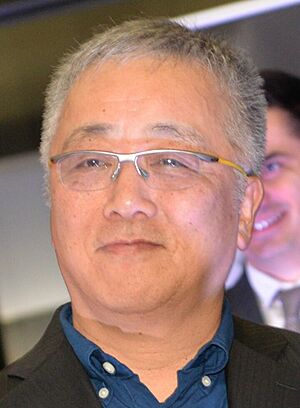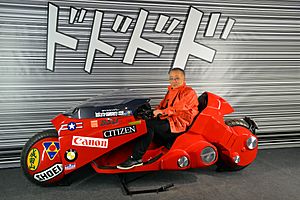Katsuhiro Otomo facts for kids
Quick facts for kids Katsuhiro Otomo大友 克洋 |
|
|---|---|

Otomo in 2016
|
|
| Born | April 14, 1954 Miyagi Prefecture, Japan |
| Nationality | Japanese |
| Area(s) | Cartoonist, Writer |
|
Notable works
|
Dōmu Akira Metropolis Steamboy |
| Awards |
|
| Spouse(s) | Yoko Otomo |
| Children | Shohei Otomo |
Katsuhiro Otomo (大友 克洋, Ōtomo Katsuhiro, born April 14, 1954) is a Japanese manga artist, screenwriter, animator, and film director. He became well-known in the 1970s as a leader of the "New Wave" in manga. He is most famous for creating Akira. This includes both the original 1982 manga series and the 1988 animated movie.
In 2005, Otomo received a special honor from France, becoming a Chevalier of the Ordre des Arts et des Lettres. He was promoted to Officier in 2014. In 2012, he became the fourth manga artist to join the American Eisner Award Hall of Fame. Japan also honored him with the Purple Medal of Honor in 2013. He also received the Winsor McCay Award in 2014 and the 2015 Grand Prix de la ville d'Angoulême. He was the first manga artist to win this French award.
Contents
Katsuhiro Otomo's Early Life and Dreams
Katsuhiro Otomo was born in Tome, Miyagi Prefecture, Japan. He grew up in a very rural area. He said there wasn't much to do as a child, so he read a lot of manga. As the only boy with sisters, he loved reading and drawing manga by himself. He started thinking about becoming a manga artist.
His parents let him buy one manga book a month. He often chose Shōnen magazine, which had Astro Boy by Osamu Tezuka and Tetsujin 28-go. He copied these drawings in elementary school. He learned how to draw manga properly after reading Shotaro Ishinomori's How to Draw Manga.
In high school, Otomo became interested in movies. This made him want to be an illustrator or a film director. A friend introduced him to an editor who saw his manga. The editor told him to contact him if he moved to Tokyo after graduating. Otomo did just that. He started his career as a professional manga artist at 19 years old.
Otomo's Creative Journey in Manga
On October 4, 1973, Otomo published his first work. It was a manga called A Gun Report. This was based on a short story by Prosper Mérimée.
In 1979, Otomo created his first science fiction manga, Fireball. Even though it was never finished, it was important for his career. It explored themes he would use in later, more famous works like Dōmu. Dōmu started being published in January 1980 and finished in July 1981. It won the Nihon SF Taisho Award in 1983 and the Seiun Award for Best Comic in 1984.
Otomo also worked with writer Toshihiko Yahagi on Kibun wa mō Sensō. This manga was about a fictional war. It was published from 1980 to 1981 and won the 1982 Seiun Award.
In 1982, Otomo began his most famous work, Akira. Publishers had asked him to create a series for their new magazine. He was busy, but finally agreed. He thought Akira would only be about ten chapters. He didn't expect it to be so popular. It was published for eight years and included 2000 pages of artwork.
In 1990, Otomo was interviewed by MTV about manga in Japan. In 1995, he created Hi no Yōjin. This story was about firefighters in Japan's Edo period.
Otomo wrote the 2002 picture book Hipira: The Little Vampire. Shinji Kimura illustrated it.
After the 2011 Tōhoku earthquake and tsunami, Otomo designed a special artwork. It shows a boy riding a robot goldfish in rough seas. This artwork is at Sendai Airport. It represents the region's strength to overcome the disaster.
In 2022, Otomo's complete manga works since 1971 were released. This project was overseen by Otomo himself. It restored some of his manga to their original versions.
Otomo's Work in Film and Animation
When he was 25, Otomo made a live-action film. This experience taught him a lot about directing movies. In 1982, he started working in anime. He designed characters for the film Harmagedon: Genma Wars. This made him realize he could direct animated films himself.
In 1987, Otomo directed his first animated work. It was a part of the movie Neo Tokyo. He also wrote the script and drew animation for it. Later that year, he directed two parts of another film called Robot Carnival. In 1988, he directed the animated movie based on his Akira manga.
Otomo was an executive producer for Memories in 1995. This film was based on three of his stories. He also wrote the scripts for two segments, Stink Bomb and Cannon Fodder. He directed Cannon Fodder as well.
Otomo has worked a lot with the studio Sunrise. He directed a short film for their Gundam series in 1998. Sunrise also produced his 2004 movie Steamboy and the 2006 Freedom Project.
The 2001 animated film Metropolis had a script written by Otomo. It was based on Osamu Tezuka's manga.
Otomo directed the 2006 live-action film Mushishi. This movie was based on a manga by Yuki Urushibara.
In 2013, Otomo was part of Short Peace, a collection of four short films. He directed Combustible, a love story set in the Edo period. This film won a Grand Prize in Japan and was considered for an Academy Award.
Otomo directed the music video for Aya Nakano's 2016 song "Juku-Hatachi". He is a fan of her music.
Reports suggest Otomo will be an executive producer for a live-action Akira movie. In 2019, he announced he is writing and directing a new animated film called Orbital Era.
Otomo's Unique Art Style and Influences
Otomo said that when he started his career in the 1970s, most manga was "gekiga," which means dramatic pictures. He wanted to create exciting science fiction manga, like the ones he loved as a child. He aimed for more realistic and believable stories.
He first tried to draw like traditional manga artists such as Osamu Tezuka. But in high school, he wanted to create characters with a more illustrative art style. Otomo tries to balance fantasy and realism in his work. He believes too much realism can harm the story, and too much fantasy can limit imagination. He said the realism in his early works came from using friends as models. French cartoonist Moebius is a big influence on Otomo's realistic character designs. Otomo is known for his visual innovations in the "New Wave" of manga.
Otomo includes nods to his favorite childhood manga in his work. He greatly respected Osamu Tezuka, Shotaro Ishinomori, and Mitsuteru Yokoyama. For example, the main computer in Fireball is named ATOM, like Tezuka's Astro Boy. The character Ecchan in Domu refers to Ishinomori's Sarutobi Ecchan. The main character of Akira is also called No. 28, a tribute to Yokoyama's Tetsujin 28-go.
Otomo has a strong interest in architecture. He puts a lot of effort into drawing detailed buildings and backgrounds. He believes this habit was influenced by Shigeru Mizuki's manga, which showed him how important backgrounds are.
When designing robots or machines, Otomo mentioned being influenced by artists like Kazutaka Miyatake and Naoyuki Kato. He enjoys many different styles and mixes them to create new ideas.
Otomo's Impact on Other Artists
Around 1979, Otomo's work became very influential in Japan. Many artists were inspired by him, including Hisashi Eguchi and Naoki Urasawa. Urasawa once said that after Osamu Tezuka created the modern manga form, Otomo changed comics again.
Masashi Kishimoto, the creator of Naruto, said Otomo was one of his biggest influences. He loved Otomo's art style the most and tried to imitate it. The creator of Dragon Ball, Akira Toriyama, also called Otomo "incredible."
Otomo's manga also influenced many Japanese video game designers in the mid-1980s. This included Yuji Horii (who created Dragon Quest) and Noritaka Funamizu (from Capcom).
Director Satoshi Kon, who worked with Otomo, said Akira and Domu were big influences on him. American film director Rian Johnson is also a fan of Otomo. He noted similarities between how telekinesis is shown in Domu and in his film Looper.
In 2017, a book called Otomo: A Global Tribute to the Mind Behind Akira was published. It featured writing and art from 80 artists from around the world. In 2021, an art gallery in New York City held an exhibition called "Good For Health, Bad For Education: A Tribute to Otomo." It showed 29 works inspired by Otomo from international artists.
Otomo's Family Life
Katsuhiro Otomo is married to Yoko Otomo. They have a son named Shohei Otomo, who is also an artist.
Otomo's Filmography
Anime Features
| Year | Title | Director | Writer |
|---|---|---|---|
| 1988 | Akira | Yes | Yes |
| 1991 | Roujin Z | No | Yes |
| 2001 | Metropolis | No | Yes |
| 2004 | Steamboy | Yes | Yes |
| TBA | Orbital Era | Yes | Yes |
Anime Shorts
| Year | Title | Director | Writer | Executive Producer |
Notes |
|---|---|---|---|---|---|
| 1987 | Construction Cancellation Order | Yes | Yes | No | Segment of Neo Tokyo |
| "Opening" and "Ending" | Yes | Yes | No | Segments of Robot Carnival | |
| 1995 | Magnetic Rose | No | Yes | Yes | Segments of Memories |
| Stink Bomb | No | Yes | Yes | ||
| Cannon Fodder | Yes | Yes | Yes | ||
| 1998 | Gundam: Mission to the Rise | Yes | Yes | No | |
| 2013 | Combustible | Yes | Yes | No | Segment of Short Peace |
Live-Action Films
| Year | Title | Director | Writer | Producer | Notes |
|---|---|---|---|---|---|
| 1982 | Jiyū wo Warera ni (じゆうを我等に) | Yes | Yes | Yes | |
| 1991 | World Apartment Horror | Yes | Yes | No | |
| 2006 | Mushishi | Yes | Yes | No |
Other Works Otomo has also contributed to other animated projects. He helped with art designs for Harmagedon: Genma Wars and the Crusher Joe film. He oversaw the Freedom Project OVA series and worked on an episode of Space Dandy. He also directed the music video Juku-Hatachi (じゅうくはたち) for Aya Nakano.
See also
 In Spanish: Katsuhiro Ōtomo para niños
In Spanish: Katsuhiro Ōtomo para niños


